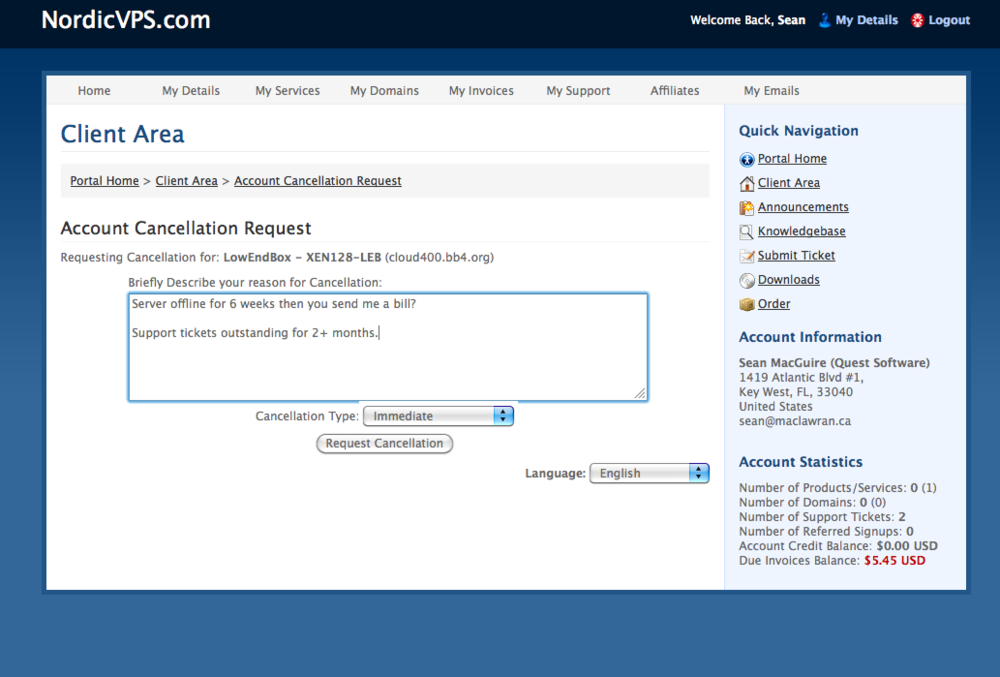What a great few years this has been. I’ve always had a machine or 10 online. Initially, we had to go out and find someone willing to allow us to put one of our machines in their facility, so we could have it online. It was Co-location. It was expensive. But it was good.
Now, I’m spoiled. I can get monster sized machines from Amazon with infinite disk. But Amazon is expensive, and I don’t expect a billion-user spike any time soon (although, who knows). The next great achievement has been virtualization – the ability to ‘chop up’ a bigger machine into a pile of smaller, virtual machines.
These virtual machines, called Virtual Private Servers (or VPS’s), are cheap. You can get your own instance of linux (I prefer Ubuntu 10.10/11.04 at the moment), for very very little money. Like $10 a month, sometimes less.
You can learn about this wild west of cheap boxes here: http://lowendbox.com and here http://www.webhostingtalk.com/
I use these for lots of things, IPV6 testing, mail servers, web servers, blogs, development, distributed monitoring since I can locate each VPS in a different area (or country for that matter). One of my favorite things to do is use these for scaling, since you can make each VPS bigger, or just buy more of them.
Combine them with Connectria for S3 storage as a linux filesystem – see my post here http://blog.maclawran.ca/s3-compatible-storage-as-a-linux-filesystem, and you too can play ‘whack a mole’ – someone takes one of your machines offline, if you set it up correctly, you could have it back online at another provider in minutes. Poor mans elevated availability 🙂
Of course such incredibly cheap access to hardware means all sorts of somewhat nefarious things can happen. On the provider side, they can oversell (so, you’ve bought a brick), have lousy network speed, or be a haven for bad guys (skiddies, spammers), or just have lousy or non-existent support.
Did I mention “avoid NordicVPS like the plague”? Sure looks like they’re circling the bowl: https://twitter.com/nordicvps
So with so many providers, how can you tell which ones are good? Here’s my list (remember I’ve been doing this since 1983… every level of support and administration concievable, including being a BOFH for a while – see http://www.theregister.co.uk/odds/bofh/)
First – the basics. Providers will try to oversell if they can. Virtualization comes in a few flavors, most often seen are OpenVZ, Xen, and KVM. OpenVZ can be insanely oversold. In reality it also means that if you your processes use too much memory, you’ll crash hard. Not nice.
I haven’t played with KVM, so I’ll pass on that. I’ve standardized on Xen. Under Xen virtualization you’re guaranteed a certain amount of memory, so even if you eat up all you’ve got, your machine will degrade in a predictible manner, swapping, thrashing, then stopping. But, it can’t be oversold, which is good.
For management interfaces I like SolusVM, which most providers use. I’ve also standardized on Ubuntu 11.04, but anything over 10.04 is actually OK, plus for me they have to support IPV6.
So you find someone. How do you know if they’re any good? Guess what. You don’t. Bwahahahahaha! But if they support IPV6 today plus Xen, their inherent cluefullness is higher from the outset.
But that’s what this post is about. I’ve tested a bunch of them, having accounts on them, asking questions, using their networks, etc. It’s also interesting to see how they handle their own outages and issues, and how well they keep their clients informed when things are going weird.
For network speed, here’s a command to test with the full discussion here: http://www.lowendtalk.com/discussion/112/test-your-vps-network-connection
wget -O /dev/null http://cachefly.cachefly.net/100mb.test
I’ve tested their support. Really tested them, because I’m hacking late into the night pretty well every night. And by late, I mean bedtime is after 5 am. And since I’ve been doing this for such a long time, if I ask support something, it’s Level 3 support asking for support, so it’s going to be interesting.
So I ask hard stuff in the middle of the night/Early in the morning. On Christmas Eve, Christmas Day… and I know instantly how good these guys are by two metrics; first the response time, second the quality of the response.
What’s interesting, is that in some of these cases, these are small hosting companies. It means they haven’t become large enough to become cheap and incompetent, maybe you’re dealing with one of the owners. It’s happened. it’s generally a good thing.
And once I’ve established a link with support (and they figure out the clue-level on the other side), then they’re happy and I’m happy. And support has been great.
I’m not going to list everyone. Suffice it to say that about half fail within 2 months.. I’m currently using:
- Empire Hosting http://empire-hosting.net – cheap – great support – blazingly fast @ 10Mbps
- YardVPS http://yardvps.com – really cheap for disk – support OK – network @ 2.7 Mbps
Honorable mention to:
- Host Virtual http://vr.org – I like these guys. They have an excellent worldwide network, support is great. and network speed was 2.46 Mbps. Not too cheap.
- GoVPSGohttp://govpsgo.com – relatively expensive, very good support, fast network @ 4.77 Mbps
- Linode http://linode.com – expensive, no IPV6, really fast network @ 11.9 Mbps (correction – IPV6 in 5/6 locations)
So if I need Worldwide VPS’s – http://vr.org wins hands down, with great support and nice guys. If I want blazing speed, value, and great support it’s Empire Hosting http://empire-hosting.net. Finally if I want the best bang for the buck and can live with a slower network it’s http://yardvps.net.
Any questions?

11 comments for “Virtual Private Servers – the Wild West of Hosting”